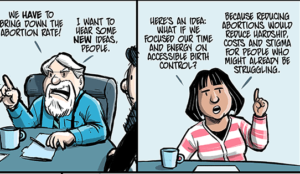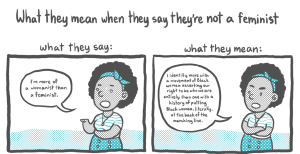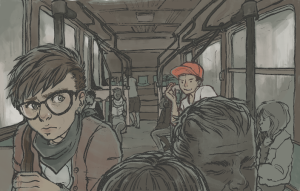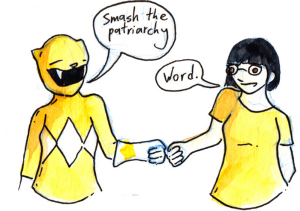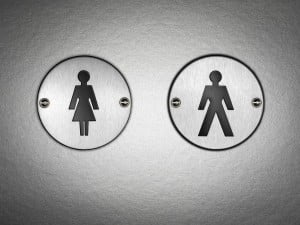
Source: ABC News
In 2012, women were statistically much poorer than men. And women that were already poor in 2011 stayed that way.
Wait a minute – you say – I’m always hearing that women make up over half of the nation’s workforce and are increasingly becoming the primary (or sole) breadwinner in families with children! Plus, isn’t the Recession over? Shouldn’t people be getting out of poverty by now?
While it’s true that our nation is in “recovery,” that’s not the whole story.
A lot of Americans are still struggling with extreme poverty – and women are getting the short end of the stick on pretty much all fronts.
Every year, the United States Census Bureau releases their findings about poverty, health insurance, and much more in September.
This year, the Census data revealed that one in seven women live in poverty. One in seven. That’s almost 17.8 million women – or 14.5% of the female population. For men, this percentage is lower, at 11%.
These crazy-high numbers of poor American women are nothing new – they are almost identical to the 2011 figures. But they’re still unacceptable.
And certain groups of women are having an even harder time than the rest.
Black, Latina, and Native American women are disproportionately poor, as are women who are the primary breadwinners in a household. And shockingly, women 65 years of age and older got drastically poorer in 2012.
In order to understand why this is happening, let’s first look at these statistics in greater detail – and at what else the newest Census data has to tell us about these different groups of women and how the post-Recession recovery period is treating them.
Women of Color Have Exceedingly High Poverty Rates
Women of Color have not prospered during the economic recovery.
The Census data shows that Black women have a whopping poverty rate of 25.1%, and Latina women come in right below them at 24.8%. Even more drastic is the plight of Native American women – one in three Native women were poor in 2012.
Poverty disproportionately affects all People of Color – not just women. Non-white children and men also suffer from poverty disproportionately across the board. As I explained in this article about American poverty, this inequality is a product of a longstanding structure of racial oppression that refuses to go away despite civil rights advances.
Poor Women Heading Households Are Getting Poorer
Studies show that in today’s working economy, four in ten households with kids under 18 years of age have a woman as the chief (or only) breadwinner.
While that fact is exciting in the sense that women are truly viable players in the workforce and completely capable of providing for their families, it doesn’t negate the fact that almost 41% of the women heading these households were poor in 2012.
Not only that, but this poverty isn’t just affecting the women themselves – it’s hurting their children.
A stunning 56% of poor kids live in families in which a woman is the main wage-earner. We’ll get to just why this is later.
Elderly Women Are Suffering More Than Before
Getting older isn’t easy on anyone, and definitely not on poor women.
Health problems become more numerous and costly, menopause changes the body dramatically, and just getting around becomes more difficult. And everything costs.
Luckily, many of us have spent a lifetime saving up for retirement to protect ourselves financially in the face of illness or other issues.
We’ve saved a bit from each paycheck, contributed to a 401K retirement plan, or made investments that will (hopefully) help see us through our old age. And ideally, we have family to back us up and take care of us as well.
But what about women who didn’t have the financial flexibility to save for retirement while they were working – or had to use their savings to help another family member in a time of need?
What about the grandmas who are still helping their children and grandchildren get by because those children are struggling with poverty themselves?
A staggering amount of elderly women are poor – and things only got worse in 2012.
According to the United States Census, the number of women 65 years or older living in extreme poverty increased by 23% last year.
That’s unacceptable. After a lifetime of contributing to our economy and society, our grandmothers should not have to worry about how they are going to afford food.
“Why is this happening?” you are probably asking yourself.
Well, there are plenty of reasons why an unequal number of women are poor.
The Wage Gap Is Partially to Blame
The ever-looming gender wage gap is one big reason.
Thanks to the Census, we know that – just like in 2011 – women who work full-time, year-round are only paid 77 cents on the dollar compared to their male coworkers – and that’s only in reference to white folk.
If you are thinking that a few cents doesn’t make much of a difference, think again.
Let’s look at what that wage gap translates into over the course of a year: Over $11k less in yearly earnings. And thus, a much smaller economic safety net. For a woman struggling with poverty, that $11 thousand could make a world of difference.
These numbers get a lot worse when you’re talking about Women of Color. Black and Latina women earn, respectively, 64 cents and 54 cents on the dollar compared to White, non-Latino men.
This inequality is a heinous relic of an oppressive, racist culture that seems to be hanging on for far too long – and yet it seems like no one is even talking about it.
The GOP is Waging a War on Safety Net Programs That Help Women
Republicans and Tea Party members in Congress and in-state chambers across the nation have their sights set on dismantling the programs that provide government assistance to needy women and families.
Nutrition aide for babies and pregnant or nursing mothers in the Supplemental Nutrition Program for Women, Infants, and Children (WIC) is on the chopping block.
So are early learning programs for kids and desperately needed food assistance for poor families.
Nothing is actually safe when it comes to the safety net – no matter how many times these programs are proven to lift millions of people out of poverty and save lives.
When these programs are cut, women and their families take the hit.
Pregnant women who lose their WIC benefits don’t get the proper help they need. Single mothers with hungry children have their food taken away from them. Mothers who rely on childcare assistance to be able to work and earn money for their families are forced to stay home.
The Supplemental Nutrition Assistance Program (SNAP), formerly known as food stamps, is a prime example.
The Census data revealed that SNAP helped 4 million people out of poverty and reduced hardship for millions of others in 2012 alone. Simply put, it is a highly effective program that made tens of millions of people less poor last year, as it does every year.
Despite these proven benefits of the program, all SNAP recipients will lose about $30 from their monthly food allotment starting November 1, 2013.
This decrease comes on top of many other cuts to the program driven by government sequestration and the threat of a $40 billion cut in the House’s proposed farm bill legislation.
Women and children will directly suffer from these cuts to SNAP. If pursued to fruition, it is very likely that next year’s Census data will disclose even more severe poverty rates for women.
With so many politicians seemingly working to keep low-income women and families in poverty – and so many other factors negatively affecting low-income women – what can be done?
Educate, Proliferate, Infiltrate!
For starters, you can share this information with everyone that you know.
I truly believe that a big reason that people vote for politicians who want to cut government assistance to the poor is that they just don’t have the facts.
If they knew who they were taking food, education, and medical services from – infants, young children, struggling families, seniors – I have a hard time believing that so many people would still agree with stripping the safety net bare.
Also, remember that the poverty data revealed by the Census is proof that low-income women are struggling – and that things are not getting much better as the economic recovery continues.
When naysayers try to tell you that the government can’t give any more money to food stamps because there are more people enrolled in the program than ever before, remind them that this is the direct result of the Great Recession.
It’s simple when you think about it.
More people fell into poverty because of a recession = more people were hungry = more people became eligible (and signed up for) nutrition assistance programs.
And since we haven’t fully “recovered” as a nation, these numbers have yet to drop back down.
Back up your arguments with facts and people will have a much harder time shooting you down.
Educate your community.
Post about these important poverty statistics on social media, e-mail articles about the Census findings to your family and friends, tweet at your members of Congress asking them to support safety net programs, or write an op-ed for your local newspaper. The Op Ed Project has some great guidelines to get you started on writing your first article.
Volunteering at community organizations that work to secure funding for low-income women is another good way to combat women’s poverty.
Look at a comprehensive volunteer site like VolunteerMatch.org to find opportunities in mentoring, educational services and much more across the country. You can also check out your local chapter of the National Organization for Women (NOW) for more ways to get involved in supporting anti-poverty measures for women.
—
You have the facts. Now go out there and do something about this inequality, with the whole force of the Census data backing you up.
Don’t let partisan politicians take necessary assistance away those who need it most.
Show them that you will fight to protect needy children, mothers, and grandmothers from falling deeper into poverty.
Want to discuss this further? Login to our online forum and start a post! If you’re not already registered as a forum user, please register first here.
Danica Johnson is a Contributing Writer at Everyday Feminism and the Communications Manager at the Coalition on Human Needs, an alliance of national organizations working together to promote public policies addressing the needs of low-income and other vulnerable populations. Living in Washington, DC, this West Coast native uses her free time to write for her blog Duckyfem, practice yoga and spend as much time with animals and in nature as possible. Follow her on Twitter @duckyfem and read her articles here.
Search our 3000+ articles!
Read our articles about:
Our online racial justice training
Used by hundreds of universities, non-profits, and businesses.
Click to learn more








